

Group 2. Daymalyn: Advantages and Disadvantages of Student Centered Learning. Teacher-Centered vs. Student-Centered Education. When considering their approach to instruction, teachers are always looking for the method that is most beneficial for all of their students.

Teachers want their students to enjoy the learning process, and they want the classroom to be orderly and controlled. As a result, the debate of teacher-centered vs. student-centered education has been in the forefront of educators’ minds for many years. Though many people have a specific idea of which type of education is best, there are both advantages and disadvantages to each approach. Below is a description of each approach, along with some pros and cons. Www.lilacconference.com/dw/programme/Presentations/Monday/OBrien_Suite/O_keefe_Cohen_introduction_to_student.pdf. Ebtesam Salem: Student-Centered Learning (Advantages and Disadvantages on the Student)
In this reflection, I will continue talking about the student-centered concept.
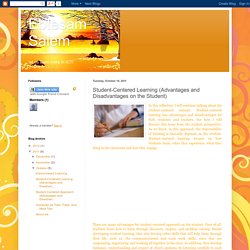
Student-centered learning has advantages and disadvantages for both students and teachers, but here I will discuss this issue from the student perspective. As we know, in this approach, the responsibility of learning is basically depends on the student. Student-centered learning focuses on how students learn, what they experience, what they bring to the classroom and how they engage. Www.fya.org.au/app/theme/default/design/assets/publications/black2007crossingthebridge.pdf. Www.assessment.uconn.edu/docs/TeacherCenteredVsLearnerCenteredParadigms.pdf. Active Learning and Student-centered Pedagogy Improve Student Attitudes and Performance in Introductory Biology. Www.ncbi.nlm.nih.gov/pmc/articles/PMC2736024/pdf/cbe203.pdf. Beyond student-centered and teacher-centered pedagogy: Teaching and learning as guided participation. Learning as Guided Participation from a variety of different angles and coordinating each organized perception into an integrated whole.
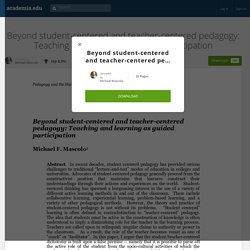
Each act of viewing the cube involves the integration of many sensory modalities (e.g. ,looking, moving the head and hands, seeing and feeling invariant patterns of movement of the body and of the cube in time and space). The product of the coordination of multiple suchactions-on-objects is the capacity to construct an integrative representation of the entire cube.This is not an insignificant point. Give (e.g., give a lecture); to learn is to take (e.g., takenotes; acquire knowledge). Material if he or she has given thelecture; a student has received the material if he or she has taken it in. Beyond the Didactic Classroom: Educational Models to Encourage Active Student Involvement in Learning.
The Advantages of Traditional Classroom Learning. Lesson Two: Comparing Traditional and Online Classrooms. The Advantages of Traditional Schools. What are the advantages/disadvantages of learning models that exist outside of traditional educational institutions? Advantages of Brain-Based Learning Environments. Advantages of Brain-Based Learning Environments 3 Lighting is important for a brain- compatible learning environment.
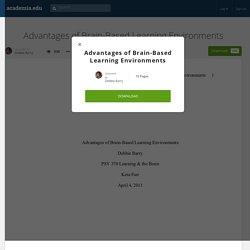
In fact, “ one of the most critical physical characteristics of the classroom is lighting ” (Ali, Hukamdad, Ghazi, Khan, 2010, para. 3). “[S]oft, full spectrum lighting is optimal for learning” (Wilmes, et. al., 2008, para. 9), while bright or harsh lighting impairs learning. Increase in the brain’s level of cortisol, which can “wreak havoc on the brain” (Jensen, 2008, p. 44). Color in the visual environment is particularly important because of its powerful impact on the brain ” (Wilmes, et. al., 2008, para. 7). Blended Learning Model Definitions.
The definition of blended learning is a formal education program in which a student learns: at least in part through online learning, with some element of student control over time, place, path, and/or pace;at least in part in a supervised brick-and-mortar location away from home;and the modalities along each student’s learning path within a course or subject are connected to provide an integrated learning experience.
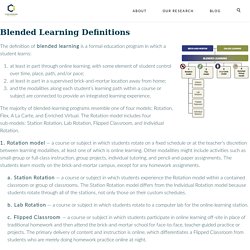
The majority of blended-learning programs resemble one of four models: Rotation, Flex, A La Carte, and Enriched Virtual. The Rotation model includes four sub-models: Station Rotation, Lab Rotation, Flipped Classroom, and Individual Rotation. 1. Rotation model — a course or subject in which students rotate on a fixed schedule or at the teacher’s discretion between learning modalities, at least one of which is online learning. Www.tree4health.org/distancelearning/sites/www.tree4health.org.distancelearning/files/readings/Ozuah-First_there_was_pedagogy.pdf. Is student-centered pedagogy impossible in Hong Kong? The case of inquiry in classrooms - Springer.
Hong Kong has been actively promoting a student-centered approach to teaching since the 1980s.

Despite this effort, students in Hong Kong still tend to be traditional learners who rarely experience and gain from real student-centered learning. While teachers hold a “quantitative” concept of learning and focus on transmitting declarative knowledge to students (Biggs and Watkins, Classroom learning: Educational psychology for the Asian teacher, 1995), students generally practise “rote learning.”
Constructive learning models such as inquiry remain little used by students in most Hong Kong classrooms. This article reports a study that examines the feasibility of implementing inquiry method in Kong Kong’s primary classrooms. It analyses the implementation and some outcomes of an inquiry-based project conducted in two local primary schools—a traditional elite Catholic school and a progressive, less-privileged school. Www.aitsl.edu.au/docs/default-source/clearinghouse/literature-review.
Unfortunately, the page or document you are looking for cannot be found.
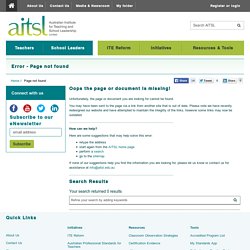
You may have been sent to the page via a link from another site that is out of date. Please note we have recently redesigned our website and have attempted to maintain the integrity of the links, however some links may now be outdated. How can we help? Here are some suggestions that may help solve this error: retype the address start again from the AITSL home page perform a search go to the sitemap If none of our suggestions help you find the information you are looking for, please let us know or contact us for assistance at info@aitsl.edu.au. The leadership of student-centred learning. This article is based on extracts from the report Literature Review: Student-Centred Schools Make the Difference, prepared for the Australian Institute for Teaching and School Leadership (AITSL) by Dr Jessica Harris, Ms Nerida Spina, Associate Professor Lisa C Ehrich and Dr Judy Smeed from the Queensland University of Technology. © Australian Institute for Teaching and School Leadership, used with permission.
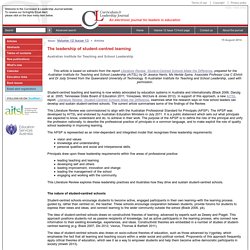
Student-centred teaching and learning is now widely advocated by education systems in Australia and internationally (Black 2006; Danzig et al. 2005; Tennessee State Board of Education 2011; Yonezawa, McClure & Jones 2012). In support of this approach, a new AITSL report, Literature Review: Student-Centred Schools Make the Difference, examines what the research says on how school leaders can develop and sustain student-centred schools.
The current article summarises some of the findings of the Review. Chinese.blogs.wm.edu/files/2013/04/Schweisfurth-2011-for-China-project.pdf. Student-Centered and Teacher-Centered Approaches: Class Notes. "When you make the finding yourself — even if youÕre the last person on Earth to see the light — youÕll never forget it.
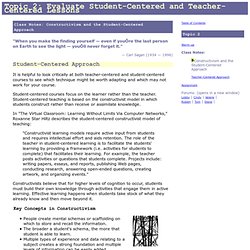
" It is helpful to look critically at both teacher-centered and student-centered courses to see which technique might be worth adapting and which may not work for your course. Student-centered courses focus on the learner rather than the teacher. Student-centered teaching is based on the constructivist model in which students construct rather than receive or assimilate knowledge. In "The Virtual Classroom: Learning Without Limits Via Computer Networks," Roxanne Star Hiltz describes the student-centered constructivist model of teaching: "Constructivist learning models require active input from students and requires intellectual effort and aids retention. Constructivists believe that for higher levels of cognition to occur, students must build their own knowledge through activities that engage them in active learning.
Files.eric.ed.gov/fulltext/EJ946152.pdf. People > Barbara Rademacher > Library > Beyond student-centered and teacher-centered pedagogy: Teaching and learning as guided participation. Www.broward.k12.fl.us/research_evaluation/researchresults%5C536ebanks%5C536Ebanks.pdf. Core.ecu.edu/engl/kaind/centerd.pdf. Www.esu-online.org/pageassets/projects/projectarchive/2010-T4SCL-Stakeholders-Forum-Leuven-An-Insight-Into-Theory-And-Practice.pdf.
Unesdoc.unesco.org/images/0021/002160/216063e.pdf. THEN: Journal. Classroom blogging in the service of student-centered pedagogy: Two high school teachers’ use of blogs Printable version April Luehmann (University of Rochester) Robyn MacBride (Greece Arcadia High School) Classroom blogs (chronologically-organized series of web-based entries orchestrated by a teacher for his/her classroom) provide a unique vehicle to elicit and hear student voices, yet we know little about how teachers and students actually use this new tool.
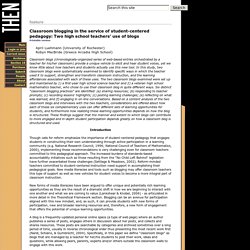
In this study, two classroom blogs were systematically examined to identify specific ways in which the teacher used it to support, strengthen and transform classroom instruction, and the learning affordances associated with each of these uses. The two classroom blogs examined were set up and maintained by 1) a first-year high school science teacher and 2) a veteran high school mathematics teacher, who chose to use their classroom blog in quite different ways.
Introduction 2) How did the students actually use the classroom blog? Multiple Intelligences Around the World - Google Books. Teacher-Centered, Learner-Centered or All of the Above. In November I had the great privilege of interviewing Parker Palmer. If you don’t know his book, The Courage to Teach, it’s one not to miss. If you haven’t read it in a while, it merits a reread. After reading it again, I found new ideas I missed the first time, old ones I have yet to understand completely and others I hadn’t thought about for far too long. Parker writes that academics have a tendency to “think the world apart.” “We look at the world through analytical lenses. It is true that for many years the pedagogical focus was on teaching.